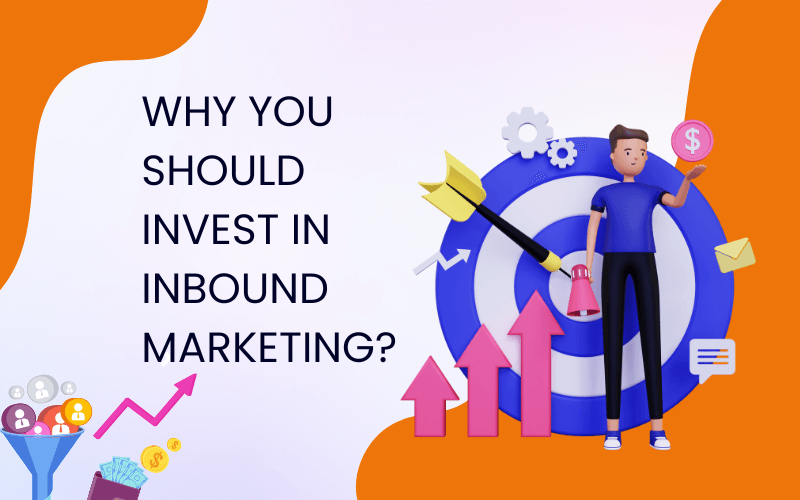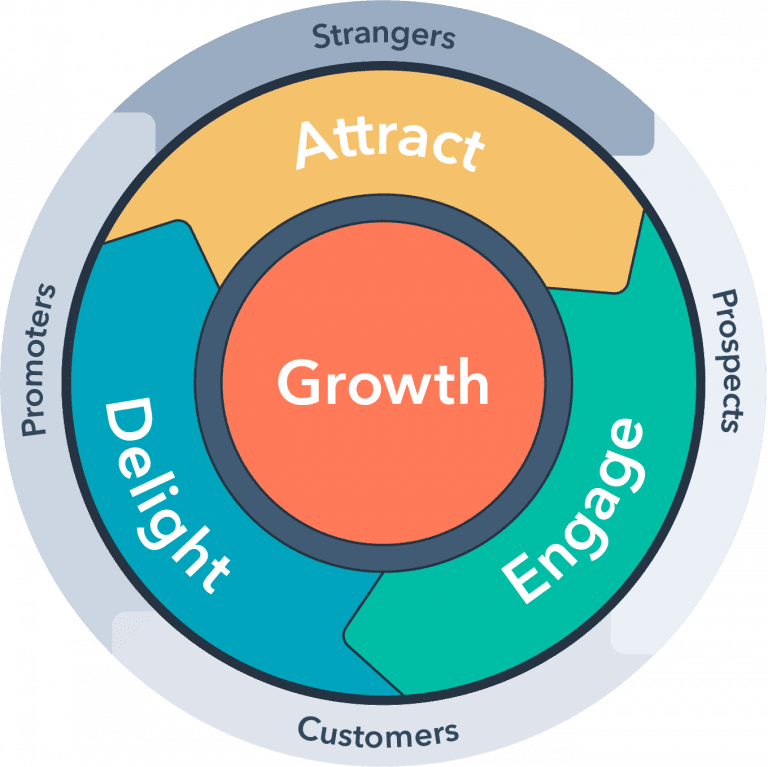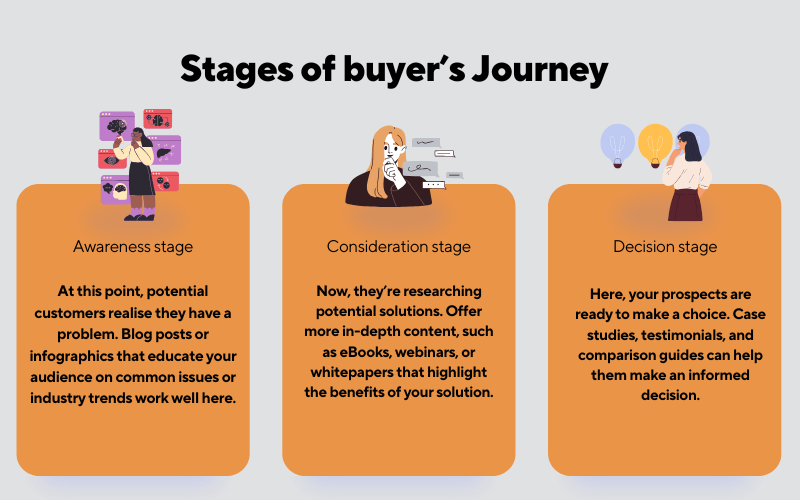Mel is our Partner Strategy & Delivery Manager and also a CIM Chartered Marketer, a testament to her commitment to excellence in the field. But Mel’s contributions don’t stop at the office door. Beyond her professional endeavours, she leads an active life as a qualified run leader and dedicated volunteer. Her experience in these roles has streamlined her leadership and teamwork skills, making her an invaluable asset when it comes to collaborating on projects and ensuring their success. Her sharp insights, strategic thinking, and knowledge have made her a backbone in our team’s ability to drive results for clients in this industry. Mel will make sure that we can approach marketing challenges from all angles and deliver outstanding results for our clients.
Posted on 18/01/2021 by Melanie Comerford
Why You Should Invest In Inbound Marketing?
Updated: January 2025

Marketing is at the core of every thriving business, but with the packed competition, standing out can’t be done with just luck. But, it also takes a smart strategy, a touch of creativity, and getting to know your audience. Cold calls and a standard advertisement campaign are not going to be as effective as they used to be five years ago.
Consumers now expect more, in terms of quantity, and not quality. They want content that’s relevant, helpful, and worth their time. With a plethora of options and ideas in the market, you can’t send a newsletter on a topic and expect consumers to be interested in it.
That’s where inbound marketing comes in. It’s a customer-first approach that’s changing the way businesses connect with people. Rather than bombarding potential customers with sales pitches, inbound marketing focuses on drawing them in by offering valuable content that answers their questions and solves their problems. It’s all about building trust and offering value – a perfect match for the smarter crowd who prefer to do their research and engage on their terms.
The statistics speak for themselves:
- 80% of marketers say inbound marketing is their primary strategy.
- Companies with strong inbound strategies generate 54% more leads than those relying solely on traditional methods.
This article dives deep into why inbound marketing is no longer optional but essential for business growth. Whether you’re a small business owner or leading a large enterprise, understanding and adopting inbound marketing can transform your results.
What Is Inbound Marketing?
Inbound marketing is a methodology that focuses on attracting customers to your businesses, by creating valuable content designed to appeal to them. Tailoring the customer experience to attract your target audience generates higher-quality leads. Whereas outbound marketing disrupts your audience by highlighting content they don’t always want, inbound marketing aims to meet the users’ needs.
Despite the introduction of intelligent CRM software, marketing automation and other tools, the core principles that have driven the success of inbound remain the same. The inbound methodology focuses on attracting high-quality leads that are more likely to purchase from you. This is why inbound methods cost less while often delivering a higher conversion rate and ROI.
A Brief Comparison with Outbound Marketing
| Outbound Marketing | Inbound Marketing |
| Interrupts the audience (e.g., ads, cold calls). | Aligns with the customer’s active search for solutions. |
| Often feels intrusive. | Feels natural and helpful. |
| Higher cost and lower ROI. | Cost-effective with sustainable results. |
Key Inbound Techniques
SEO (Search Engine Optimisation)
SEO ensures your website ranks high on search engine results pages (SERPs). By optimising your content with relevant keywords, you attract organic traffic. For example, businesses that consistently blog see 67% more leads than those that don’t.
Content Marketing
From blog posts and eBooks to how-to guides and videos, content marketing is the backbone of inbound. Sharing valuable insights establishes your authority and keeps your audience engaged.
Social Media
Social media platforms like Instagram, Facebook, and LinkedIn are perfect for connecting with your audience. Regular posting, responding to comments, and sharing user-generated content humanises your brand.
Email Marketing
Personalised email campaigns nurture leads, turning curious prospects into loyal customers. With tailored messaging, you can guide users through every stage of their buying journey.
Benefits of Inbound Marketing
What makes the inbound methodology effective is how it incorporates a range of marketing techniques. This ensures all channels are synchronised to attract, engage, and delight future customers. It does this through a combination of content marketing, SEO, blogs, and social media. The inbound methodology is divided into three stages, each stage in the flywheel is designed to nurture your prospective buyers into the next stage of their journey to making a purchasing decision.

Attract: Entice the right people through valuable content and conversations that establish you as a thought leader in your industry who they can trust. Aim to earn a prospect’s trust which will make them want to engage with you.
Engage: Introduce insights and solutions that line up with your prospect’s pain points.
Delight: Provide support to empower customers to find success with their purchase as when customers find success, they’re likely to share it with others. This has the potential to attract more prospects to your business and act as a constant cycle.
The beauty of inbound marketing lies in the interconnectedness of these stages, creating a seamless and unified customer experience. Let’s dive into how these benefits translate into real results.
Increase Brand Awareness
Before purchasing products or services, 81% of consumers research options online. Even more revealing, people spend an average of 79 days exploring products before making a purchase.
When your company ranks at the top of search engine results or appears on social networks, it raises your brand awareness. Inbound marketing helps improve your search engine rankings through high-value content, optimised for SEO.
By aligning this content with the buyer’s journey, you increase the chances of your target audience finding your business at the crucial research stage. Over 26% of clicks on search engine results pages (SERPs) occur on the first link, which demonstrates just how valuable ranking positions are to businesses.
Creating content that matches the needs of your audience builds trust and encourages them to return to your website throughout their research phase. They’re also more likely to share compelling content on social media, which further increases your visibility as a knowledgeable and trustworthy resource in your industry.
Attract High-Quality Leads
The key to success in inbound marketing is attracting the right leads, people who are genuinely interested in what you offer and are more likely to make a purchase. By focusing on the quality of your leads, you not only meet the needs of your potential customers but also improve your conversion rates.
Traditional marketing methods often aim to generate as many leads as possible, regardless of their relevance to your business. In contrast, inbound marketing focuses on attracting more qualified leads who are actively searching for the information you provide. These visitors are already looking for solutions that your business or B2B business can offer, which makes them much more likely to convert.
By publishing valuable, helpful content, you build meaningful relationships with potential customers. The inbound methodology raises awareness, nurtures leads, and ultimately drives users to take action, whether that’s making a purchase or filling out a contact form.
Deliver A High ROI
Demonstrating return on investment (ROI) is crucial for any marketing strategy. Inbound marketing is a cost-effective approach that provides measurable results. By focusing your budget on attracting higher-quality leads, you save money while targeting prospects who are more likely to become loyal customers.
Note that inbound marketing is a long-term strategy, but its rewards are worth the wait. Consistent blogging, SEO, and social media efforts often lead to compounding results. Within 6-12 months, many businesses see exponential traffic growth and lead.
Outbound marketing methods, like cold calling and display ads, can be expensive and often yield uncertain results. Even if outbound methods generate more traffic, if that traffic isn’t relevant, the conversion rate will remain low. Inbound marketing ensures that your resources are spent on attracting qualified leads who are already interested in your offering.
Sustainable Marketing
Inbound marketing is a sustainable long-term business strategy. When customers are satisfied with their experience, they’re more likely to share it with others, whether that’s through word-of-mouth or social media. A positive experience with your brand creates the potential for new leads without needing to invest further resources in traditional advertising.
When your customers are delighted, they become advocates for your business. By securing a sale, you create an opportunity to market to future customers, as word of mouth continues to build your reputation. The more happy customers you have, the more likely they are to create a steady stream of new business for you.
Build Trust Signals
Trust is one of the most important factors in converting leads into customers. 91% of consumers say they are more likely to purchase from a business they trust. Inbound marketing naturally fosters trust by providing valuable, insightful content that answers your audience’s questions and addresses their pain points.
Unlike outbound methods, which can interrupt a user’s journey, inbound marketing allows visitors to choose your business because they actively sought out your content. By delivering relevant information, you show that you understand your audience’s needs. The more useful content you provide, the stronger the trust signals you send. When people share positive experiences with your brand, it boosts your credibility even further.
Improved Customer Loyalty
Attracting new customers is essential, but retaining them is just as important. Inbound marketing’s “Delight” stage is all about fostering long-term relationships by offering exceptional post-purchase experiences. It’s about continuing to add value and engage with your customers even after they’ve made a purchase.
Repeat customers are more likely to become brand advocates, sharing your products and services with friends, family, and colleagues. 65% of a company’s business comes from repeat customers. Offering post-purchase support, such as personalised follow-up emails or helpful guides, can enhance customers feel valued and appreciated, creating stronger loyalty and encouraging repeat business.
Marketing Automation
One of the most exciting aspects of inbound marketing is the ability to scale efforts with automation. Tools like CRM (Customer Relationship Management) and marketing automation software enable businesses to streamline their processes, making them more efficient and effective.
For example, 80% of companies report that automation has significantly increased their lead generation. Automated email campaigns can be personalised based on customer behaviour, such as browsing a product or signing up for a newsletter. Similarly, automated lead nurturing sequences deliver the right content to the right person at the right time, helping guide them through the buyer’s journey with minimal effort from your team.
These tools not only save time but also allow you to reach and engage leads at scale, ensuring your inbound marketing efforts are both efficient and effective.
How to Get Started with Inbound Marketing
Inbound marketing can be a game-changer for your business, but knowing how to get started can be a bit overwhelming. Don’t worry! This guide breaks down the process into easy-to-follow steps so you can implement inbound marketing strategies and start reaping the benefits.
Step 1: Define Your Goals
Before diving into inbound marketing, it’s essential to define clear goals. Setting SMART objectives (Specific, Measurable, Achievable, Relevant, and Time-bound) is key to ensuring your efforts are focused and effective.
For example, rather than setting a vague goal like “increase traffic”, make it more specific and measurable, like “Increase website traffic by 25% over the next 6 months.” By doing so, you give yourself a clear target and can track your progress.
Here’s a breakdown of SMART goals:
- Specific: What exactly do you want to achieve?
- Measurable: How will you measure success? For instance, using website analytics.
- Achievable: Is this goal realistic based on your resources and capabilities?
- Relevant: Does this goal align with your business objectives?
- Relevant: What’s your deadline for achieving this goal?
Step 2: Understand Your Audience
One of the core principles of inbound marketing is delivering content that resonates with your target audience. To do this, you need to understand who your audience is.
Start by researching your audience’s demographics, such as age, location, and job roles. But don’t stop there, dig deeper into their behaviour and preferences. What are their pain points? What problems are they looking to solve? Where do they spend their time online?
To help with this, create detailed buyer personas. These are semi-fictional representations of your ideal customers, based on research and real data. A buyer persona might include:
- Name and background
- Job role and goals
- Challenges and pain points
- Preferred content types (blog posts, videos, etc.)
- Buying Behaviour
Step 3: Develop High-Value Content
Content is the heart of inbound marketing. To attract the right audience, you need to develop high-value content that speaks directly to their needs and interests.
Start by creating content that aligns with the stages of the buyer’s journey

Step 4: Leverage Marketing Tools
Using the right marketing tools can make all the difference when it comes to managing and optimising your inbound efforts.
For lead management, CRM software (Customer Relationship Management) helps you track interactions with potential customers and nurture those relationships. Tools like HubSpot or Mailchimp can help you automate your marketing, from email campaigns to social media posts, allowing you to reach customers with the right message at the right time.
Step 5: Measure and Optimise
Inbound marketing is an ongoing process, which means it’s important to measure and optimise your efforts. Track key performance indicators (KPIs) like:
- Website Traffic
- Lead generation
- Conversion rates
- Customer retention
By analysing these KPIs, you can identify areas for improvement and refine your strategy to deliver better results. Remember, inbound marketing isn’t a “set it and forget it” approach. It requires continuous evaluation and optimisation to ensure long-term success.
How Can We Help?
At Loop Digital, we understand that inbound marketing can be overwhelming, especially if you’re just starting out. That’s where we come in! Our team of experts is here to help you create and implement a successful inbound marketing strategy that generates real, tangible results for your business.
We specialise in crafting bespoke inbound marketing plans tailored specifically to your business needs. Whether you’re looking to increase brand awareness, generate high-quality leads, or boost your ROI, we’ll work with you to design a strategy that fits your goals and delivers measurable success.If you’re ready to see the power of inbound marketing in action, get in touch with us today. Let’s discuss how we can support your business growth with our expertise and services. We’re here to help you attract, convert, and delight your customers with a strategy that works.
Looking for your next opportunity?
Digital marketing careers
We’re always on the lookout for talented individuals to join our ever growing team. If you think you’d be a great match for Loop Digital, we’d love to hear from you.

Join 300+ business owners getting weekly growth strategies - subscribe now.
"*" indicates required fields







